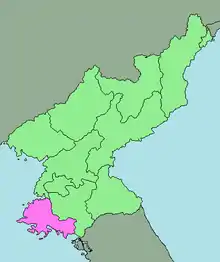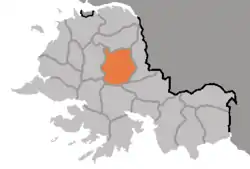Sinchon Massacre
The Sinchon Massacre (Korean: 신천 양민학살 사건; Hanja: 信川良民虐殺事件; lit. Sinchon Civilian Massacre[1]) was a massacre of civilians between 17 October and 7 December 1950,[1] in or near the town of Sinchon (currently part of South Hwanghae Province, North Korea). North Korean sources claim the massacre was committed by the U.S. military and that 30,000–35,383 people were killed in Sinchon.[3] South Korean sources dispute the death toll and accuse Korean right-wing security police and communists of the killings.[3] The event took place during the second phase of the Korean War and the retreat of the North Korean government from Hwanghae Province.[4]
| Sinchon Massacre | |
|---|---|
| Part of Korean War | |
| Location | Sinchon, North Korea |
| Coordinates | 38°21′16″N 125°28′50″E |
| Date | 17 October 1950 – 7 December 1950[1] |
| Target | Sinchon residents[1] |
Attack type | Massacre |
| Deaths | 30,000[1]–35,383[2] (North Korean claim) |
| Accused | South Korean Army, United States Armed Forces (North Korean claim) Anti-Communists, Communists (South Korean sources)[1] |


North Korean claim
According to North Korean sources, approximately 35,000 people were killed by American military forces and their supporters during the span of 52 days. This figure represents about one-quarter of the population of Sinchon at the time.[5] The Sinchon Museum of American War Atrocities, established in 1958, displays the remains and belongings of those who were killed in the incident.[6] In schools, North Koreans are taught that Americans "hammered nails into victims' heads" and "sliced off women's breasts." Officials "copy all the images from the museum and plaster them all over school corridors."[7]
According to a dispatch, titled "Sinchon simmering with rage", released on 3 July 1998 by the Korean Central News Agency:
The Yankees separated the mothers from their children before pouring gasoline at the children and babies who were crying for drinking water and milk. When the children and babies sucked gasoline and were crying, feeling great pains, the Yankees threw flaming torches to kill them. They also threw explosives at the mothers. The American soldiers drowned over 2,000 innocent people by dropping them from Soktang bridge. They also drowned more than 1,000 women in Sowon reservoir. Upwards of 1,200 patriotic-minded people detained in an ice warehouse were bitten to death by military dogs. The head of master Yun Hae Won of Jungsan Primary School was sawed up alive. The eyeballs and breasts of chairwoman Pak Yong Gyo of the women’s union of the Sinchon Tobacco Factory were gouged out. The enemies disembowled a pregnant woman to hold up a 9 month-old embryo on the end of a bayonet, laughing aloud. The yankees massacred 35,383 innocent Koreans, or a quarter of the population of Sinchon in 52 days of their occupation of the place. Exhibited in the Sinchon Museum are 6,465 items of evidences and some 450 pictures showing the man-hunting of the U.S. imperialist brutes. A survey group of the International Association of Lawyers published a joint communique in 1952 bitterly denouncing the U.S. imperialists’ massacre in Sinchon as an unprecedented-in-scope murder. The Korean people will remember the massacre for all ages and requite blood with blood.[8]
Kim Jong-il visited the museum in 1998. Kim Jong-un visited in November 2014 to "strengthen the anti-U.S. lessons for our military and people... and to powerfully unite the 10 million soldiers and people in the battle against the United States."[9] In July 2015, Kim Jong-un visited again with senior military official Hwang Pyong-so, revealing a major expansion of the Sinchon massacre museum.[10]
NGO claims
In a report prepared in Pyongyang, the non-governmental and historically Communist-affiliated[11][12][13] International Association of Democratic Lawyers lists several alleged incidents of mass murder by U.S. soldiers in Sinchon.[14] In addition, they claimed that the American troops had beheaded up to 300 North Koreans using Japanese samurai swords, and that the US Air Force was using bacteriological warfare in Korea.[15]: 156 Relying on oral testimony from North Koreans, the International Association of Democratic Lawyers report claims that the Sinchon massacre was overseen by a General "Harrison" or "Halison", an apparent reference to William Kelly Harrison, whom they allege personally conducted many of the atrocities. Their report claims that Harrison took photos of the massacre; however, there is no evidence to confirm their testimony.
Harrison was reportedly shocked by the claim.[16] Investigative reports have concluded there was no Harrison in the area at the time, and that this was either a pseudonym or a false claim. The Museum in Sinchon has a photo of a man, allegedly Harrison, giving the full name "Harrison D. Maddon." The photo shows a tall man standing to the left of a wreath with a UN flag over it, his back turned to the camera, his face not visible, holding a cap in his hand behind his back, and another, indistinct object visible immediately in front of the man.[17][18][19]
According to Dong-Choon Kim, a former commissioner of the Truth and Reconciliation Commission, the Sinchon massacre was carried out by "right-wing security police and a youth group."[2] Sunghoon Han says that "right-wing security units" were responsible for the killings.[15]: 157–158, 166–167
The South Korea-based Institute for Korean Historical Studies concluded that both Communists and anti-Communist vigilantes engaged in wholesale slaughter throughout the area and that the 19th Infantry Regiment took the city and failed to prevent the secret police that came with them from perpetrating the civilian murders; however, the TFD did not participate themselves. Furthermore, according to the institute, when Communists retook the city, the population was again purged.[18][3] South Korean novelist Hwang Sok-yong claims that the massacre was caused by a local rivalry that used the fog of war as a pretense.[20]
In 1989, Chicago Tribune, the journalist Uli Schmitzer wrote:
If any truth about massacres in Chichon (Sinchon) ever existed, the evidence has long ago been obscured. The town, 70 miles [110 km] south of the North Korean capital, Pyongyang, has been turned into a national shrine by a ruthless propaganda machine that has fueled anti-American passions for 36 years in support of an institutionalized, regimented communist regime.[21]
The author Bruce Cumings, in his book War and Television, stated:
the major part of the Sinch’on massacres were carried out by Korean Christians who had fled the Sinch’on area for the South. In my opinion, If any Americans were present they were probably KMAG [Korean Military Advisory Group] personnel, who witnessed many South Korean atrocities against civilians; the Koreans I spoke with were adamant that Americans had carried out the massacres, but it is also true that Koreans do not like to admit that Koreans could do such things, unless they are following American or (in the colonial period) Japanese orders.[22][23]
Representation in other media
- South Korean novelist Hwang Sok-yong's novel The Guest, based on interviews with a Korean Christian pastor, addresses the Sinchon massacre.[15]: 153
See also
- List of massacres in North Korea
- List of massacres in South Korea
- Massacre in Korea, a painting by Pablo Picasso, depicting the Sinchon massacre
- Sinchon Museum of American War Atrocities
References
- "< 북에서의 6.25 '미군만행' 확인될까 >". JoongAng Daily (in Korean). 16 May 2001. Archived from the original on 19 June 2013. Retrieved 3 August 2012.
{{cite news}}: CS1 maint: unfit URL (link) - Kim, Dong-Choon (December 2004). "Forgotten war, forgotten massacres—the Korean War (1950–1953) as licensed mass killings". Journal of Genocide Research. 6 (4): 536. doi:10.1080/1462352042000320592. S2CID 74141018.
- "The Truth About the Sinchun Massacre". Archived from the original on 19 June 2013.
- "How North Korea turned a civil war conflict into anti-US propaganda | NK News". NK News - North Korea News. 8 July 2022.
- "More Remains and Relics Displayed at Sinchon Museum". KCNA. 26 November 2008. Archived from the original on 12 October 2014. Retrieved 4 April 2015.
- Past news Archived 9 June 2011 at the Wayback Machine
- "Interviews with North Korean who escaped". YouTube.
- "Sinchon simmering with rage". Korean Central News Agency. Archived from the original on 12 September 2001. Retrieved 29 August 2021.
- Finley, JC (25 November 2014). "North Korea's Kim Jong Un labels Americans 'cannibals'". UPI. Retrieved 8 August 2015.
- Shim, Elizabeth (22 July 2015). "Kim Jong Un visits anti-U.S. museum ahead of war anniversary". UPI. Retrieved 8 August 2015.
- "It can happen here: A study of communist intrigue". The Round Table: The Commonwealth Journal of International Affairs. 44 (176): 353–362. September 1954. doi:10.1080/00358535408451896.
- Van Daal, A.J.M. (October 1955). Under False Colors: A report on the Character of the International Association of Democratic Lawyers (PDF). The Hague: International Commission of Jurists.
- Donert, Celia (12 April 2016). "From Communist Internationalism to Human Rights: Gender, Violence and International Law in the Women's International Democratic Federation Mission to North Korea, 1951". Contemporary European History. 25 (2): 313–333. doi:10.1017/S0960777316000096. S2CID 159814571.
- Report on U.S. Crimes in Korea (PDF). Pyongyang: International Association of Democratic Lawyers. 1952. Archived from the original (PDF) on 2 October 2013.
- Han, Sunghoon (March 2015). "The Ongoing Korean War at the Sinch'ŏn Museum in North Korea" (PDF). Cross-Currents: East Asian History and Culture Review (14): 152–177. Archived from the original (PDF) on 11 December 2015. Retrieved 8 August 2015.
- Facts Forum vol. 4, no. 6 (1955), p. 5
- "General Harrison Maddon Illustration – Sinchon Museum of American War Atrocities". 18 September 2009.
- Institute for Korean Historical Studies. 《사진과 그림으로보는 북한현대사》 p91~p93
- "The Truth About the Sinchun Massacre". korean-war.com. 28 April 2002. Archived from the original on 8 March 2012. Retrieved 15 December 2021.
- "The haunted battlefield • International Socialism". 6 April 2006.
- , Chicago Tribune, 21 August 1989
- Adam Cathcart, "Notes on the Sinchon Massacre", Blog, 16 May 2015
- Bruce Cummings, War and Television, 1994
Further reading
- Jong-yil Ra "Governing North Korea. Some Afterthoughts on the Autumn of 1950". Journal of Contemporary History Vol. 40, No. 3 (Jul. 2005), pp. 521–546 doi:10.1177/0022009405054570